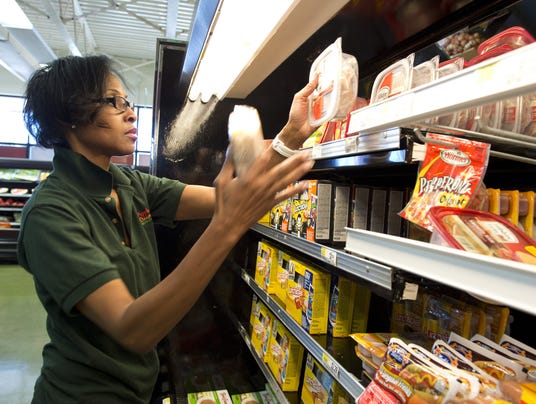At the bustling weekly Sunday farmers' market here, $7 buys a gallon of freshly pressed apple cider, $10 a wedge of award-winning goat cheese. Eight kinds of melons spill over one farmer's table, while another overflows with organic kale, collard greens and purple heirloom tomatoes. If there was ever a sign of post-recession abundance and prosperity in the USA, this would be it.
Yet in the span of a few hours Sunday morning, dozens of shoppers queued up at an unmarked awning near the market's entrance, each handing over a bright orange debit card that allows them to buy fresh fruits and vegetables with federal food stamp benefits. City workers swiped the bright orange "Independence Cards" 53 times. The contrast suggests just how far the USA still has to go to pull out of its economic malaise, and Census Bureau data released today confirm it: 13.6% of U.S. households received federal Supplemental Nutrition Assistance Program (SNAP) benefits last year, up from 13% in 2011 and only 8.6% in 2008 at the height of the recession. For many here and elsewhere, this is the Recovery That Wasn't.
[...]
Experts say part of the rise in food stamps results from states expanding eligibility but that much of the past few years' increase is due to extended unemployment.
"In this economy we still have millions of individuals out of work," says Stacy Dean ofthe liberal Center on Budget and Policy Priorities. Poverty in America today, she says, is largely a story of unemployed workers or those who must combine their wages with public assistance in order to survive. "It's either that the wages or the hours are insufficient in order to be a living income."
Congress is debating whether to tighten eligibility, which could reduce the number of people receiving the food aid. House Majority Leader Eric Cantor, R-Va., supports allowing states to require able-bodied recipients to spend 20 hours a week in either a job or job training. And a House vote on cutting nearly $4 billion a year from food stamp assistance could come Thursday. (emphasis mine)View the Statistics by City/State below. CLICK MAP to open the interactive version:
Read the rest of the story HERE.
If you like what you see, please "Like" us on Facebook either here or here.
Please follow us on Twitter here.
Please follow us on Twitter here.






No comments:
Post a Comment